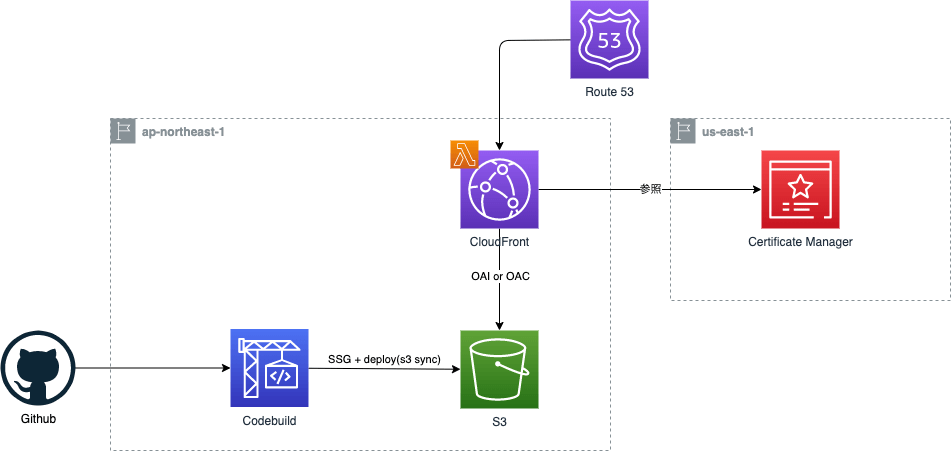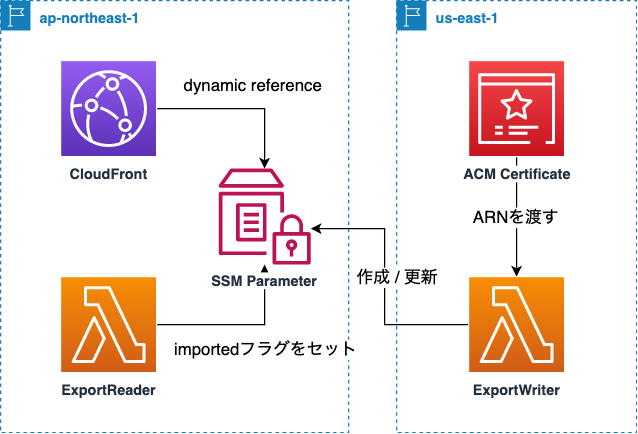# やりたいこと
- zenn に記事を書いたときに自分のブログにも投稿したい
- 勉強のため aws で作りたい
- 勉強のため app router を使いたい
- 独自ドメインにしたい
- aws リソースは aws-cdk で作りたい
# できたもの
このチュートリアル手順 + 少し md のスタイルとかの調整などしています
ホーム | tatsumiyamamoto.com
web開発に関する技術を中心に紹介するブログです。
以下のような感じになっています
- zenn-cli を使って github リポジトリと同期(push 時に自動投稿)
- git push 時に codebuild が走って s3 へデプロイ(自分のブログにデプロイ)

# 準備
準備
mkdir zenn-next-s3-cloudfront
cd zenn-next-s3-cloudfront
git init
npx create-next-app --ts
# Need to install the following packages:
# create-next-app
# Ok to proceed? (y) y
# ✔ What is your project named? … frontend
# ✔ Would you like to use ESLint with this project? … Yes
# ✔ Would you like to use Tailwind CSS with this project? … No
# ✔ Would you like to use `src/` directory with this project? … Yes
# ✔ Use App Router (recommended)? … Yes
# ✔ Would you like to customize the default import alias? … No
mkdir infra
cd infra
npx cdk init app --language typescript
tree -aL 1
.
├── .git
├── frontend
└── infra
4 directories, 0 files
# app router で SSG する
## zod のインストール
zodを入れる
npm i zod
## ディレクトリ構成
ディレクトリ構成
tree -aL 4
.
└── app
├── _libs
│ └── article.ts
├── articles
│ └── [id]
│ └── page.tsx
├── favicon.ico
├── layout.tsx
└── page.tsx
5 directories, 5 files
## 作っていく
_libs/article.ts
import { z } from "zod";
export const articleSchema = z.object({
id: z.number(),
userId: z.number(),
title: z.string(),
completed: z.boolean(),
});
export const articlesSchema = z.array(articleSchema);
export type Article = z.infer<typeof articleSchema>;
export type Articles = z.infer<typeof articlesSchema>;
export const getArticle = async (id: string): Promise<Article> => {
try {
const res = await fetch(
`https://jsonplaceholder.typicode.com/todos/${encodeURIComponent(id)}`
);
const article = await res.json();
return articleSchema.parse(article);
} catch (err: unknown) {
if (err instanceof z.ZodError) {
throw new Error(
`Invalid article data: ${err.errors.map((e) => e.message).join(", ")}`
);
}
throw err;
}
};
export const getArticles = async (): Promise<Articles> => {
try {
const res = await fetch("https://jsonplaceholder.typicode.com/todos");
const articles = await res.json();
return articlesSchema.parse(articles);
} catch (err: unknown) {
if (err instanceof z.ZodError) {
throw new Error(
`Invalid article data: ${err.errors.map((e) => e.message).join(", ")}`
);
}
throw err;
}
};
page.tsx
import Link from "next/link";
import { getArticles } from "./_libs/article";
export default async function Home() {
const articles = await getArticles();
return (
<main>
{articles.map((article) => {
return (
<Link
href={`/articles/${encodeURIComponent(article.id)}`}
key={article.id}
>
<h2>{`${article.id} ${article.title}`}</h2>
</Link>
);
})}
</main>
);
}
articles/[id]/page.tsx
import { getArticle, getArticles } from "@/app/_libs/article";
export async function generateStaticParams() {
const articles = await getArticles();
const params = articles.map((article) => {
return {
id: article.id.toString(),
};
});
return params;
}
export default async function Article({ params }: { params: { id: string } }) {
const article = await getArticle(params.id);
return (
<div>
<h1>Article {article.id}</h1>
<p>{article.title}</p>
</div>
);
}
## npm scripts の設定
app router では以下のようにすることで静的ファイルのエクスポートができます
next.config.js
/** @type {import('next').NextConfig} */
const nextConfig = {
output: "export", // next build時にoutディレクトリに静的エクスポート(以前のnext exportコマンド)
};
module.exports = nextConfig;
package.json
{
"name": "frontend",
"version": "0.1.0",
"private": true,
"scripts": {
"dev": "next dev",
"build": "next build",
"start": "npx serve@latest out", // 'output': 'export'を設定しているときは next start ではなくこちらを使う
"lint": "next lint"
},
"dependencies": {
"@types/node": "20.3.0",
"@types/react": "18.2.11",
"@types/react-dom": "18.2.4",
"eslint": "8.42.0",
"eslint-config-next": "13.4.5",
"next": "13.4.5",
"react": "18.2.0",
"react-dom": "18.2.0",
"typescript": "5.1.3",
"zod": "^3.21.4"
}
}
以上のように設定し、以下のコマンドを実行します
ビルドして動作確認する
npm run build # next buildコマンドが実行され ./out 配下にSSGされる
npm start # http://localhost:3000 でサーバーが立ち上がる
# aws-cdk で静的サイトホスティングを独自ドメインで作る
## ドメインを取得しておく
以下のサイトとかを参考に route53 でドメインを取得します。
chigusa-web.com
Amazon Route53 でドメインを取得する - Qiita
全体の流れドメインを取得する ←今回の投稿ドメインにALBを割り当てるHTTPS化するもくじ取得するドメインを選択するメールアドレスを認証するドメインが登録されたことを確認参考ドメ…

## s3+cloudfront の stack を作る
基本的には以下の記事と同じですが、route53 への A レコードの登録を追加でしたりします。
tatsumiyamamoto.com
infra/lib/infra-stack.ts
import {
App,
CfnOutput,
RemovalPolicy,
Stack,
StackProps,
aws_cloudfront,
aws_cloudfront_origins,
aws_codebuild,
aws_iam,
aws_route53,
aws_route53_targets,
aws_s3,
aws_s3_deployment,
} from "aws-cdk-lib";
import { Certificate } from "aws-cdk-lib/aws-certificatemanager";
import { IHostedZone } from "aws-cdk-lib/aws-route53";
import "dotenv/config";
type ZennS3CloudFrontProps = StackProps & {
domainName: string;
certificate: Certificate;
publicHostedZone: IHostedZone;
};
const OWNER = process.env.GITHUB_OWNER ?? "";
const REPO = process.env.GITHUB_REPO ?? "";
const BRANCH = process.env.GITHUB_BRANCH ?? "";
const GOOGLE_SEARCH_CONSOLE_VERIFICATION =
process.env.GOOGLE_SITE_VERIFICATION ?? "";
export class ZennS3CloudFrontStack extends Stack {
constructor(scope: App, id: string, props: ZennS3CloudFrontProps) {
super(scope, id, props);
const { domainName, certificate, publicHostedZone } = props;
// 静的ホスティング用のバケットを作成
const bucket = new aws_s3.Bucket(this, "ZennStaticHostingBucket", {
bucketName: "zenn-static-hosting-bucket",
removalPolicy: RemovalPolicy.DESTROY, // destroy時にバケットを削除する
autoDeleteObjects: true, // destroy時にバケット内のオブジェクトも削除する
});
// cloudfront用のoriginAccessIdentityを作成
const originAccessIdentity = new aws_cloudfront.OriginAccessIdentity(
this,
"ZennOriginAccessIdentity",
{
comment: "ZennBlogOriginAccessIdentity",
}
);
// bucket policyを作成
const bucketPolicy = new aws_iam.PolicyStatement({
actions: ["s3:GetObject"], // GetObjectのみ許可
resources: [`${bucket.bucketArn}/*`], // バケット内の全てのオブジェクトを対象
// originAccessIdentityから(CloudFront経由でのアクセス)のみを許可
principals: [
new aws_iam.CanonicalUserPrincipal(
originAccessIdentity.cloudFrontOriginAccessIdentityS3CanonicalUserId
),
],
});
// bucketにpolicyを追加
bucket.addToResourcePolicy(bucketPolicy);
// ルーティングの調整を行う
const cloudFrontFuntion = new aws_cloudfront.Function(
this,
"CloudFrontFunction",
{
code: aws_cloudfront.FunctionCode.fromFile({
filePath: "lib/cloudfront-function.js",
}),
}
);
const distribution = new aws_cloudfront.Distribution(
this,
"BlogDistribution",
{
comment: "ZennBlogDistribution",
defaultRootObject: "index.html",
defaultBehavior: {
compress: true,
viewerProtocolPolicy:
aws_cloudfront.ViewerProtocolPolicy.REDIRECT_TO_HTTPS,
allowedMethods: aws_cloudfront.AllowedMethods.ALLOW_GET_HEAD,
origin: new aws_cloudfront_origins.S3Origin(bucket, {
originAccessIdentity,
}),
functionAssociations: [
{
function: cloudFrontFuntion,
eventType: aws_cloudfront.FunctionEventType.VIEWER_REQUEST,
},
],
},
errorResponses: [
{
httpStatus: 404,
responseHttpStatus: 404,
responsePagePath: "/404.html",
},
],
certificate,
domainNames: [domainName],
}
);
// Aレコードを作成
new aws_route53.ARecord(this, "ZennBlogARecord", {
recordName: domainName,
zone: publicHostedZone,
target: aws_route53.RecordTarget.fromAlias(
new aws_route53_targets.CloudFrontTarget(distribution)
),
});
// Google Search Console用のTXTレコードを作成
new aws_route53.TxtRecord(this, "ZennBlogGoogleSearchConsoleRecord", {
recordName: domainName,
zone: publicHostedZone,
values: [
`google-site-verification=${GOOGLE_SEARCH_CONSOLE_VERIFICATION}`,
],
});
// s3にデプロイ
new aws_s3_deployment.BucketDeployment(this, "ZennBlogBucketDeployment", {
destinationBucket: bucket,
distribution,
sources: [
aws_s3_deployment.Source.data(
"/index.html",
"<html><body><h1>Hello, World!</h1></body></html>"
),
],
});
const buildSpec = {
version: "0.2",
phases: {
pre_build: {
commands: ["cd frontend && npm ci"],
},
build: {
commands: ["npm run build"],
},
post_build: {
commands: [
"aws s3 sync ./out s3://(バケット名) --delete", // s3 cp ではなく s3 syncでデプロイすることで既存ファイルの削除も行うことができる
],
},
},
};
// codebuild用のroleを作成
const codebuildRole = new aws_iam.Role(this, "CodeBuildRole", {
roleName: "ZennBlogCodeBuildRole",
assumedBy: new aws_iam.ServicePrincipal("codebuild.amazonaws.com"),
});
// s3へのアクセス権限を追加
codebuildRole.addManagedPolicy(
aws_iam.ManagedPolicy.fromAwsManagedPolicyName("AmazonS3FullAccess")
);
const codebuild = new aws_codebuild.Project(this, "CodeBuild", {
projectName: "ZennBlogCodeBuild",
source: aws_codebuild.Source.gitHub({
owner: OWNER,
repo: REPO,
branchOrRef: BRANCH,
webhook: true,
}),
environment: {
privileged: true,
buildImage: aws_codebuild.LinuxBuildImage.STANDARD_7_0,
},
buildSpec: aws_codebuild.BuildSpec.fromObject(buildSpec),
role: codebuildRole,
cache: aws_codebuild.Cache.bucket(bucket),
});
new CfnOutput(this, "URL", {
value: `https://${domainName}`,
});
}
}
lib/cloudfront-function.js
// cloudfront functionはES6以前の記法で書く必要がある
// アロー関数, let, constなどは使えない
function handler(event) {
var request = event.request;
var uri = request.uri;
// '/'の場合はindex.htmlを返す
if (uri === "/") return request;
var filename = uri.split("/").pop();
if (!filename) {
return {
status: "302",
statusDescription: "Found",
headers: {
location: [
{
key: "Location",
value: uri.replace(/\/+$/, "") || "/",
},
],
},
};
} else if (!filename.includes(".")) {
request.uri = uri.concat(".html");
}
return request;
}
## cloudfront 用の証明書を us-east-1 で取る必要がある
cloudfront 用の証明書は us-east-1 で取る必要があります。
AWS CDK Tips: クロスリージョンのデプロイ - maybe daily dev notes
AWS CDK TIpsシリーズの記事です。 AWSでサービスを構築する際、単一リージョンで提供するサービスであっても、クロスリージョンのデプロイが必要になる場合がまれにあります。AWS CDKでは、そのような構成も簡単に実装可能です。今回はCDKを使ったクロスリージョンアプリのデプロイ方法をまとめます。 クロスリージョンの必要な状況 まず、クロスリージョンのデプロイが必要になるのはどのような場合でしょうか? DRやレイテンシー低減を考慮したマルチリージョンのアーキテクチャでは、もちろん必要でしょう。しかし実はそうでない場合、つまり単一リージョンで提供するサービスであっても、次の場合などにクロ…

aws-cdk では同じ app construct で別の region の stack をデプロイすることができます
[AWS CDK] 同じApp Construct内で異なるリージョンのStackをデプロイできるのか試してみた | DevelopersIO
結論:できました。
![[AWS CDK] 同じApp Construct内で異なるリージョンのStackをデプロイできるのか試してみた | DevelopersIO](https://devio2023-media.developers.io/wp-content/uploads/2019/08/aws-cloud-development-kit.png)
これを用いて、
- us-east-1 で証明書を取得
- ap-northeast-1 などの別リージョン(s3 + cloudfront を立てたいリージョン)で証明書を使う
という方法でいきます。
infra/lib/us-east-1-stack.ts
import {
App,
Stack,
StackProps,
aws_certificatemanager,
aws_route53,
} from "aws-cdk-lib";
import { Certificate } from "aws-cdk-lib/aws-certificatemanager";
import { IHostedZone } from "aws-cdk-lib/aws-route53";
type ZennUsEast1StackProps = StackProps & {
domainName: string;
};
export class ZennUsEast1Stack extends Stack {
public readonly publicHostedZone: IHostedZone;
public readonly certificate: Certificate;
constructor(scope: App, id: string, props: ZennUsEast1StackProps) {
super(scope, id, props);
const { domainName } = props;
// パブリックホストゾーンを作成
const publicHostedZone = aws_route53.HostedZone.fromLookup(
this,
"ZennHostedZone",
{
domainName,
}
);
// cloudfrontように証明書を作成(cloudfrontの制約でus-east-1で作成する必要がある)
const certificate = new aws_certificatemanager.Certificate(
this,
"ZennCertificate",
{
domainName,
certificateName: "ZennCertificate",
validation:
aws_certificatemanager.CertificateValidation.fromDns(
publicHostedZone
),
}
);
this.certificate = certificate;
this.publicHostedZone = publicHostedZone;
}
}
## ルーティングの調整を cloudfront function で行う
そのままの設定だとルーティングがうまくいかないので、lambda@edge または cloudfront function を使って調整をします。 cloudfront function は古い JS の記法しか使えなかったり容量制限がありますが、lambda@edge に比べて安いみたいです。
Next.js で SSG したサイトを AWS CloudFront + S3 にデプロイする - Qiita
はじめに最近 Next.js の SSG (Static Site Generator: 静的サイト生成) の機能が強化されにわかに盛り上がっています。SSG の用途では今までは Gatsby.…

## クロスリージョンな stack のデプロイ
上で作成した二つの stack をデプロイします。stack を作成する際のコンストラクタの引数として、作成先の region と、crossRegionReferences: trueを指定することでクロスリージョン参照ができるようになります。
infra/bin/infra.ts
#!/usr/bin/env node
import "source-map-support/register";
import * as cdk from "aws-cdk-lib";
import { ZennUsEast1Stack } from "../lib/us-east-1-stack";
import { ZennS3CloudFrontStack } from "../lib/infra-stack";
const app = new cdk.App();
const domainName = '独自ドメイン(例.https://google.com)'
const usEast1 = new ZennUsEast1Stack(app, "UsEast1Stack", {
env: {
account: 'アカウントID'
region: "us-east-1",
},
crossRegionReferences: true, // クロスリージョン参照をON
domainName,
});
new ZennS3CloudFrontStack(app, "ZennS3CloudFrontStack", {
env: {
account: 'アカウントID'
region: 's3 + cloudfrontを作成したい先のregion(例. ap-northeast-1)'
},
crossRegionReferences: true, // クロスリージョン参照をON
domainName,
// usEast1スタックからの参照
certificate: usEast1.certificate,
publicHostedZone: usEast1.publicHostedZone,
});
# デプロイ
関連するStackをすべてデプロイする
npx cdk deploy --all
# デプロイしたリソースの削除
リソースを削除する
npx cdk destroy